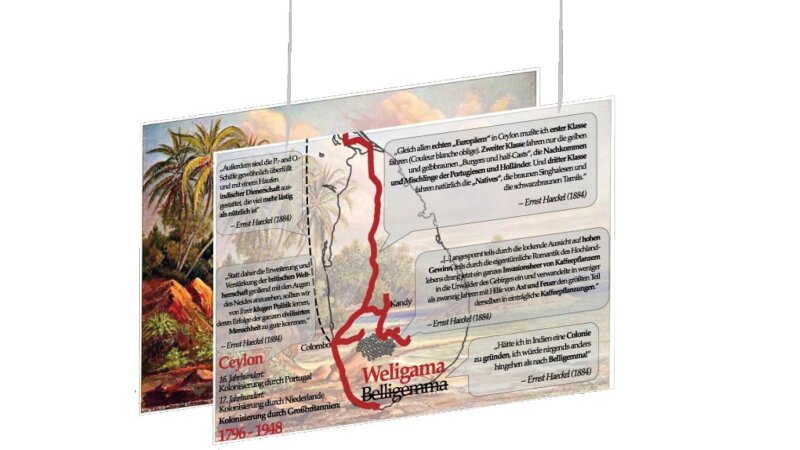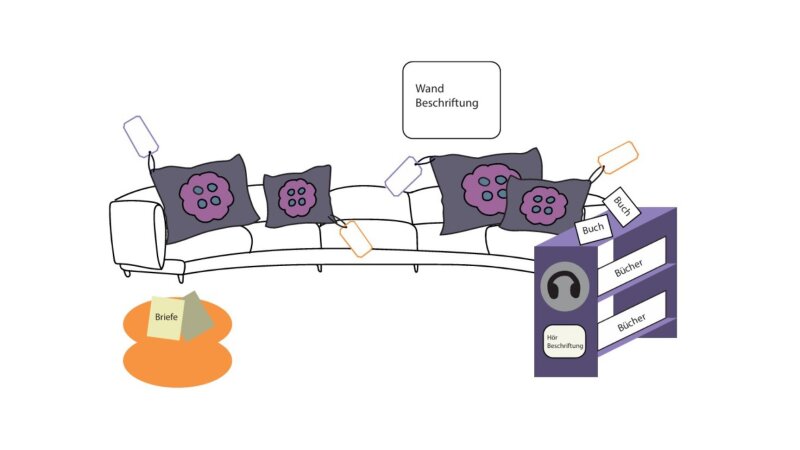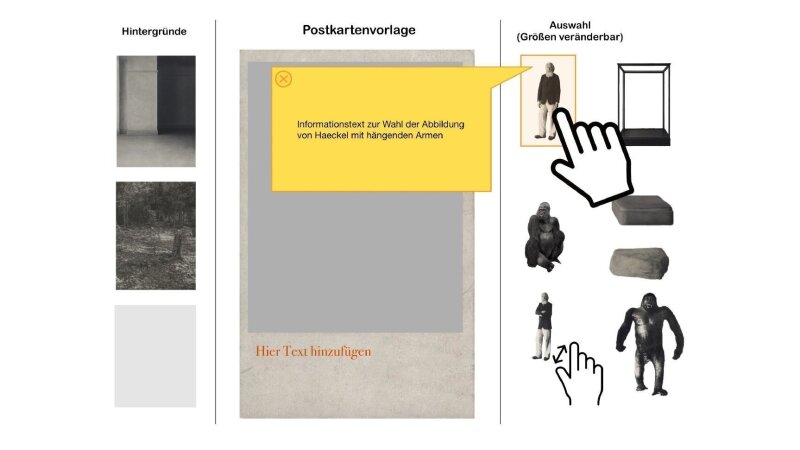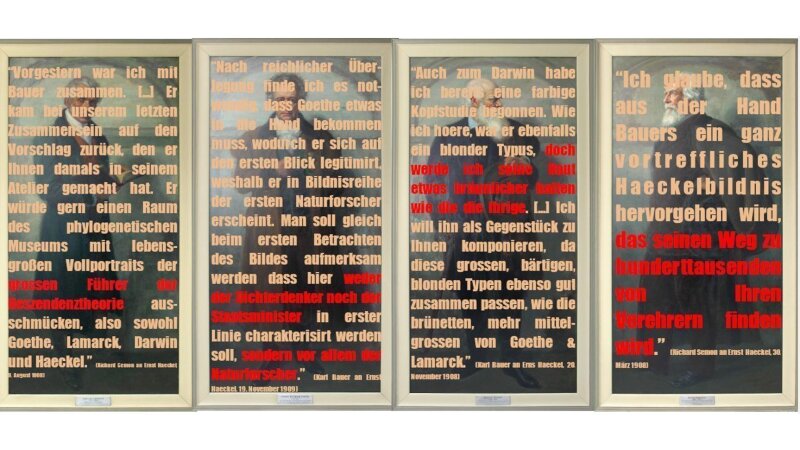
Prof. Dr. Daniela DöringExternal link held a seminar on racism-critical curating at Merseburg University of Applied Sciences in cooperation with the Ernst Haeckel House in Jena in the summer semester of 2025.
Using various objects from the Ernst Haeckel House collection, the Master's students from the Applied Media and Cultural StudiesExternal link programme developed ideas on how they could be exhibited.
Seminar papers by students on the History of Natural Sciences master's programme, contributions to the forthcoming anthology of the 'Ernst Haeckel Postcolonial' workshop and texts by staff at the Ernst Haeckel House provided the basis for the examination of the objects in terms of the history of science.
Many thanks for the numerous ideas and the inspiring discussion:
Students from Merseburg University of Applied Sciences and the University of Jena, Daniela Döring (Merseburg University of Applied Sciences), Matthias Krüger and Bernd Bock (Phyletic Museum) and Ulrike Lötzsch (Anatomical Collection).
As part of the curatorial concept for the bronze statuette “Ernst Haeckel as a Naturalist in Ceylon 1881,” we examine the exhibit, its context, and the accompanying narrative with regard to its problematic nature in the exhibition context. First, the statuette is described as the bearer of a colonial narrative: it depicts Haeckel in a heroic pose, thereby reproducing the idealization of European knowledge production, while colonial power and violence relations remain hidden. The chosen presentation format deliberately breaks with this visual language. The statuette is to be presented lying down, thereby deconstructing its heroic character and depriving it of its symbolic power. This gesture is complemented by several empty pedestals or pedestals filled with miniature replicas, which refer to Haeckel's invisible companions and victims of his research through their names. The intervention aims to open up perspectives critical of racism by making colonial omissions, epistemic hierarchies, and the continuing effects of colonial power structures in knowledge production visible. The concept is intended as a contribution to the deconstruction of colonial narratives of heroism and to raising awareness of the power interrelationships between science, colonialism, and curatorial narratives.
concept idea: Marius Dörner, Hannah Lüken
scientific basis: Sarah Becker (Master's student in the history of science
/Uni Jena)
Haeckel's colonial journey brought into focus. A curatorial concept critical of racism based on the oil painting Cocos Island near Belligemma (Gan Duva) Ceylon (1881)
Sketch for the presentation of an image
Image: Skadi Pest, Anna-Amina ZeidanThe intervention “Haeckel's Colonial Journey in Pictures” uses the painting Cocos Island near Belligemma (1881) to place Ernst Haeckel's research trip to India and Ceylon in its colonial context. The paradisiacal, untouched landscape of the painting is disrupted by uncomfortable colonial realities that are invisible in the image. Haeckel himself helps to uncover these realities: quotations from his travel diaries are intended to reveal his role within the colonial system.
concept idea: Skadi Pest, Anna-Amina Zeidan
scientific basis: Prof. Dr. Petra Löffler (Theory and history of contemporary media/Carl von Ossietzky Universität Oldenburg)
Just a pillow? Rough concept for an object-oriented strategy for anti-racist exhibition practices
Sketch of a sofa with cushions
Image: Annika Grenzow, Ann Ramm, Lea ZeilerA lounge installation featuring replicas of Ella von Crompton's Discomedusa pillow invites visitors to engage in a calm but critical examination of the role of women in Haeckel's time. In particular, the cult of genius surrounding Haeckel is to be critically reflected upon through her admiration of him. Texts, audio recordings, and workshops create a space for reflection that can be experienced without the classic museum distance, but with sensitive contextualization critical of racism.
concept idea: Annika Grenzow, Ann Ramm, Lea Zeiler
scientific basis: Charlotte Fuchs (Master's student in the history of science
/Uni Jena)
lumbung - collective practice for revising a colonial archive
Sketch of a hinged display case
Image: Franziska Hüls, Johanna SpeckertOnce a “small souvenir” of Sumatra, the model of the rice barn is to be detached from Haeckel's interpretive power and repositioned through the collective Indonesian lumbung practice. The staging opens up space to get to know the rice barn in a multidimensional way, beyond misogynistic and racist attributions.
concept idea: Franziska Hüls, Johanna Speckert
scientific basis: Weijun Qin (Master's student in the history of science
/Uni Jena)
Attention, elite! Rough concept for an object-oriented strategy for anti-racist exhibition design based on Ernst Haeckel's brain
Sketch of a magazine cabinet
Image: Clara Richter und Paula GötzeAfter Haeckel's death, his brain was removed, preserved, and examined in detail in the context of “elite brain research.” This research assumed that a white, European, and male elite represented the highest stage of human development. Ethnic groups living in colonized areas, on the other hand, were assigned a lower level of development, which was used to legitimize oppression and exploitation. In order to highlight the unequal treatment of human life, Haeckel's heart is juxtaposed with the “scalp of a Herero” in the staging concept. This scalp presumably came to Jena illegally during the German genocide of the Herero people. The concept envisages depicting both objects in an illustration of an archive shelf modeled on the archive of the Phyletic Museum. Two flaps are to be integrated into this illustration, behind which information and a visualization of the massive difference in the treatment of the objects can be found. The greatest challenge of this concept is to depict the unequal treatment without reproducing it. Whether this will succeed remains to be seen.
concept idea: Clara Richter, Paula Götze
scientific basis: Dr. Ulrike Lötzsch (anatomical collection/Uni Jena)
Post(colonial) greetings. Haeckel and the gorilla postcard – Rough concept for an object-oriented strategy for exhibiting in a way that is critical of racism
Sketch of an interactive station for postcards
Image: Fanny Anna Feierabend, Franz Oeser, Judith TaubertAs part of the interactive station on Ernst Haeckel's postcard featuring the stuffed gorilla, visitors are encouraged to critically examine the colonial, anthropocentric, and patriarchal structures that provided the context for Haeckel's staging of his original postcard through an informative, digital deconstruction and reconstruction of the postcard. The opportunity to comment on other designs afterwards also creates an open space for constructive exchange.
concept idea: Fanny Anna Feierabend, Franz Oeser, Judith Taubert
scientific basis: Bastienne Karg (Ernst-Haeckel-Haus/Uni Jena)
The Heroes. A postcolonial curatorial concept
Sketch for an intervention on a series of paintings
Image: Finn Lennart Blug, Hendrik GrafThe intervention addresses the question of how to deal with the myth of genius. The focus is on the series of paintings that the artist Karl Bauer himself described as “The Heroes of Developmental History.” How can we break down a one-sided, glorifying perspective on these scientists? The installation of a glass pane is intended to encourage visitors to take other perspectives and critically examine the staging of scientists. Quotes from the correspondence regarding the commission and intentions of the large-scale paintings are to be projected onto the pane and be temporarily visible and invisible. This allows the respective image to be viewed undisturbed from every perspective. The intervention aims to stimulate a discussion of the ideological stance of Karl Bauer and Ernst Haeckel.
concept idea:Finn Lennart Blug, Hendrik Graf
scientific basis: Bastienne Karg (Ernst-Haeckel-Haus/Uni Jena)





